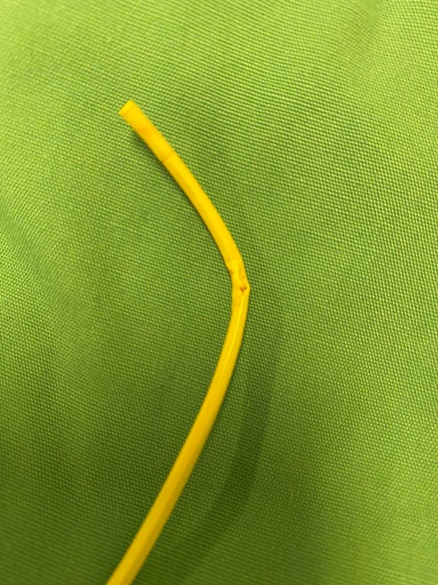Pulmonary Artery Catheter Sutured on the Pulmonary Trunk and Relevant Clinical Consequences
To the Editor,
We present a case of intraoperative Pulmonary Artery Catheter (PAC) sutured on the pulmonary trunk, requiring re-operation to remove it.
A 75-year old female presented to surgery for aortic valve replacement due to aortic valve stenosis. A pulmonary artery catheter was inserted before the operation started for haemodynamic monitoring and facilitation during the separation of Cardiopulmonary Bypass (CPB). The measurements and waves displayed on the monitor were normal throughout the procedure. A free mobility check of PAC was performed right after the CBP weaning, but not before chest closure. The surgery was otherwise uneventful, except for a minor bleeding on the previous site of the vent placed at the pulmonary trunk, requiring extra suturing. A few hours later, the patient was haemodynamically stable and ready for extubation. As soon as she was extubated and fully oriented, PAC withdrawal was attempted. Immediately, a strong resistance was met, along with a strong feeling of heart pulsation.
The PAC balloon was further deflated, with no difference at the resistance. Recent imaging modality showed the PAC end in the pulmonary artery, while transthoracic echo (TTE) confirmed this position, with no signs of movement during manipulation. As the surgeon recalled suturing in the area towards the end of the operation, the patient was again led to the OR to remove the sutured PAC (Figure 1) under general anaesthesia. At the end of the procedure the patient was again extubated, however she developed a serious postoperative delirium, which lasted for six days, causing major concern among her family and prolonging the in-hospital length of stay. She was discharged on the eighth postoperative day, after the delirium was subsided.
Figure 1: Sutured PAC in the Pulmonary Artery.
Several cases have been reported in the literature concerning adverse events due to the PAC use, but not all required reoperation. In our case, a second surgery contributed to a postoperative delirium onset, attributed to repeated exposure to anaesthesia [1].
The use of PAC during cardiac surgery, although diminished lately, is offering valuable haemodynamic guidance, especially in the absence of alternative monitoring, such as transesophageal echo (TOE) or minimally invasive cardiac output monitors [2]. However, there are no structured guidelines concerning the optimal positioning during the CPB so as to avoid related complications, or the suggested method to confirm its right placement. Action is needed towards the development of such guidelines [3].
Nevertheless, when a PAC is used during cardiac anaesthesia, a check of its free mobility just before chest closure should always be performed in order to identify a possible PAC entrapment and avoid the need for reoperation.
Declaration of Patient Consent
The authors certify that they have obtained all appropriate patient consent forms. In the form the patient has given her consent for their clinical information to be reported in the journal. The patient understands that their names and initials will not be published and due efforts will be made to conceal their identity, but anonymity cannot be guaranteed.
Funding
None.
Conflicts of Interest
None.
Article Info
Article Type
Letter to the EditorPublication history
Received: Thu 02, Feb 2023Accepted: Thu 23, Feb 2023
Published: Tue 14, Mar 2023
Copyright
© 2023 Evangelia Samara. This is an open-access article distributed under the terms of the Creative Commons Attribution License, which permits unrestricted use, distribution, and reproduction in any medium, provided the original author and source are credited. Hosting by Science Repository.DOI: 10.31487/j.ACR.2023.01.01
Author Info
Evangelia Samara Stavros Siminelakis Agathi Karakosta Petros Tzimas
Corresponding Author
Evangelia SamaraDepartment of Anesthesiology and Postoperative Intensive Care, University of Ioannina, Ioannina, Greece
Figures & Tables

References
1.
Tzimas
P, Andritsos E, Arnaoutoglou E, Papathanakos G, Papadopoulos G (2016)
SHORT-TERM POSTOPERATIVE COGNITIVE FUNCTION OF ELDERLY PATIENTS UNDERGOING
FIRST VERSUS REPEATED EXPOSURE TO GENERAL ANESTHESIA. Middle East J Anaesthesiol 23: 535-542.
[Crossref]
2. Sarkar M, Umbarkar S (2021) Pulmonary artery catheter - Dilemma is still on? Ann Card Anaesth 24: 1-3 [Crossref]
3. Samara E, El Tahan MR (2022) Where should we leave the wild "Raa Raa" during cardiopulmonary bypass? J Cardiothorac Vasc Anesth 36: 4208-4212. [Crossref]
